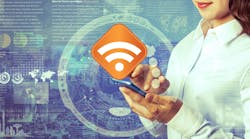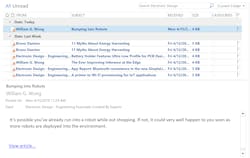We hope that Electronic Design is a regular stop for keeping track of the electronics industry, but we’re only one of thousands of sources available through the internet. Keeping up to date with all of the latest news and information is impossible these days, even with tools like Twitter, Facebook, or other social-media platforms. Staying abreast of content by visiting websites is next to impossible when done individually. RSS feeds are one way to deal with the massive amount of information created daily.
If you know what an RSS or news feed is, then you might pick up a few tips here. If not, then this article may help streamline how you gather news and information about any number of topics from engineering and software to food and gardening.
RSS feeds, or Really Simple Syndication, are a way for websites to expose collections of articles on the site. They’re also known as news feeds and other terms, but they all refer to the same general technology.
In general, RSS feeds are streams of content that include a title and summary like that found on most website home pages. However, instead of having a specific layout like a website, an RSS feed can be rendered in a variety of formats depending on the RSS reader being employed. One I use with the Firefox browser is called Feedbro (Fig. 1). Most web browsers even have their own built-in RSS feed support, with many presenting and organizing content from RSS feeds into favorites or bookmarks folders. The Opera web browser calls them Personal News.
1. RSS feeds can be viewed in web browsers using plugins like Feedbro for Firefox (click on image for larger version).
Fitting Your Needs
Typically, an RSS reader will let you customize how RSS feed entries are presented and collated. Minimally, an entry will include a title and a summary; it’s possible to simply view a list of titles. This may be sufficient enough for more investigation and the final task of displaying the source article in a web browser. That’s why web-based RSS readers are often the easiest way to use RSS feeds.
RSS reader support will at least present an individual feed as a single list, but it’s often more useful to see a collection of RSS feeds in a folder as a group. This list is usually organized by posting date, so you can quickly view the latest articles for numerous lists/websites. It’s an easy way to see trends and duplicate coverage.
Many readers support filtering and search capabilities. It’s often more useful than using search engines like Bing, Google, or Yahoo because the content that will be found is limited to that in the RSS feeds. The downside is that the searches will only examine titles and summary content.
Most RSS readers download the RSS feed contents; the frequency and retention can be configured. For many solutions, it’s possible to do this down to the feed. RSS readers also typically keep track of what entries have been viewed as summaries or visited using a web browser. This is very useful when trying to quickly examine entries and not have to view the same entry multiple times. It’s also a way to keep track of what new entries have yet to be read, which is important as the number of sources in your collection grows large.
You can check your browser’s support by viewing the URL of an RSS feed like that of Electronic Design (http://electronicdesign.com/rss.xml). The way RSS feeds are presented can be different and often customizable. For example, Opera’s default presentation presents the first image in the feed along with the title and summary (Fig. 2).
2. Opera’s default presentation presents the first image in the feed along with the title and summary.
Many email programs like Microsoft’s Outlook (Fig. 3) can capture RSS feeds and present them as email content. This has the advantage of collecting content from email sources as well as RSS feeds in one application and using the search and filtering features when looking for a particular type of content.
3. Many email programs like Microsoft Outlook can capture RSS feeds.
For those on smartwatches, smartphones, and tablets, there are apps for RSS feeds. Search for RSS feeds or news-feed readers in your favorite app store. You will find hundreds of options for most platforms. It’s worth checking out a few to find one that suits your needs—all RSS feed readers are not created equal. There are also applications for most PC platforms, including Windows, Mac OS, and Linux. Many of these apps, like Feedly, have matching websites that you can use as well.
Numerous news syndication websites and apps are available, too. These are often driven by RSS feeds and typically present options grouped by topic so that you can construct your own content collection. The advantage of these apps and sites is ease of selecting content sources that they have curated for you. On the other hand, it can be difficult to include feeds not in their list. It’s one reason why I prefer open-source apps that let me add my own sources.
These options represent just the RSS basics. They should get you going with RSS feeds. Check out the more advanced alternatives as you hit a few dozen to a couple hundred feeds. Yes, you can go overboard, but you will find that the tools become as invaluable as the content you’re going to have access to.
Organizing
How you organize your content in the RSS readers can affect how quickly you can find new content, as well as how you can partition your viewing pleasure. I have folders within folders in my RSS readers and I use multiple apps for different platforms because of how they present and filter information. For example, I have a folder for my favorite bloggers. That folder has folders for bloggers of different topic areas such as programming and hardware.
I do the same for dozens of newspapers and news sites. I can easily drill down to a topic or collection quickly. I rarely view a top-level list of all content sources in one list because it’s overwhelming. Likewise, I don’t review all folders on a daily basis. I have a collection that I do and others that get visited weekly, or on a whim, or when I’m searching a particular topic area.
If you’re sharing lists, then you will likely run into the Outline Processor Markup Language (OPML) file format. This is used for all sort of things, including exchanging RSS feed links. Many RSS reader applications can export their lists using this format and import them as well. It can be useful for backup and restore operations, too. Other file formats are used, but OPML is one of the more common around.
I didn’t mention RSS feed formats yet. There are a few, but it’s not worth going into detail about them. Likewise, the URL file type can also vary and may or may not match the file format. The Atom XML format is the most common. RSS readers will typically support all formats in use on the internet.
Finding a URL for an RSS feed can be easy if you use the tools typically built into an RSS reader or web browser. Some provide lists of RSS feeds maintained by the application or website associated with the reader. Most will also search a web page to find an RSS feed link embedded on the page. A handful of sites will include those links associated with a news-feed icon. Click the icon to view the RSS feed and, depending on your browser or reader, add it to your collection of RSS feeds.
Of course, keep Electronic Design and its sister publications in mind. I included our RSS feed URLs so that you don’t have to search for them, but don’t forget the rest of Informa’s online publications. That list is even more extensive.
- Electronic Design
- Hydraulics and Pneumatics
- Machine Design
- Microwaves and RF
- Power Electronics
- Source Today
Hopefully this has opened up a new, more useful source of content on the internet that’s more manageable than search results and more customizable than the major syndicated news sites.




